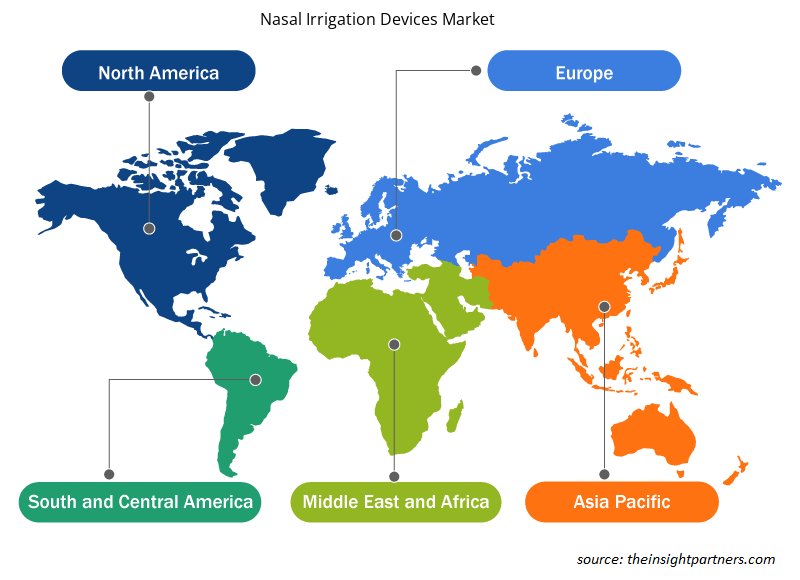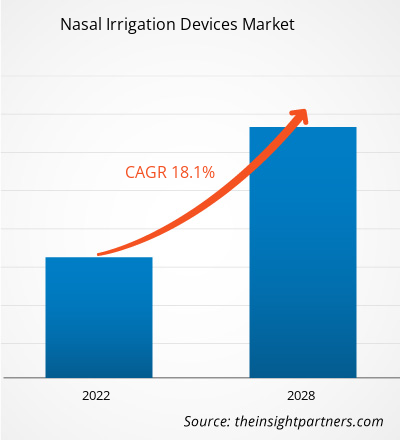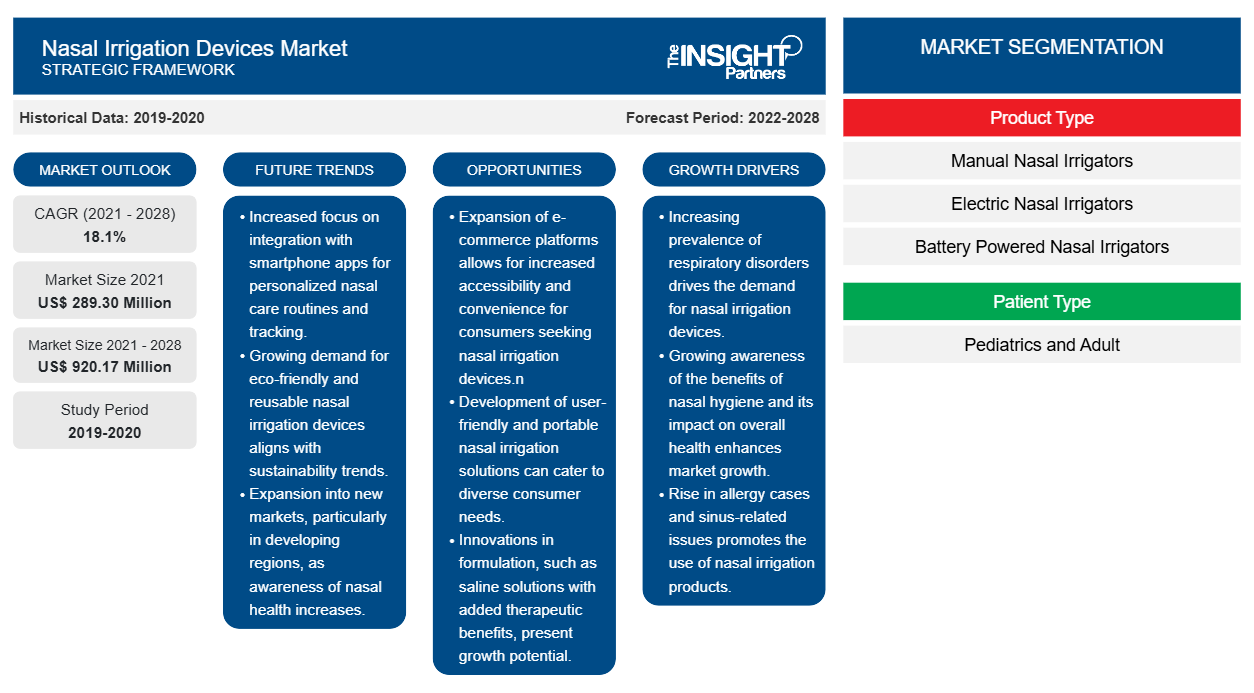El mercado de dispositivos de irrigación nasal se valoró en US$ 289,30 millones en 2021 y se estima que crecerá a una CAGR del 18,1% entre 2022 y 2028.
La irrigación nasal es una práctica tradicional de limpieza de las fosas nasales con la ayuda de solución salina y agua destilada mediante dispositivos como el Neti Pot, la botella exprimible y los irrigadores nasales eléctricos. Estos dispositivos tienen boquillas especialmente diseñadas que ayudan a una limpieza eficiente y eficaz de las fosas nasales.
El mercado de dispositivos de irrigación nasal está segmentado por tipo de producto, tipo de paciente, aplicación, usuario final y geografía. Por geografía, el mercado está ampliamente segmentado en América del Norte, Europa, Asia Pacífico, Oriente Medio y África, y América del Sur y Central. Este informe ofrece información y un análisis profundo del mercado, haciendo hincapié en parámetros como las tendencias y la dinámica del mercado. También incluye el análisis competitivo de los principales actores del mercado de dispositivos de irrigación nasal.
Personalice este informe según sus necesidades
Obtendrá personalización en cualquier informe, sin cargo, incluidas partes de este informe o análisis a nivel de país, paquete de datos de Excel, así como también grandes ofertas y descuentos para empresas emergentes y universidades.
-
Obtenga las principales tendencias clave del mercado de este informe.Esta muestra GRATUITA incluirá análisis de datos, desde tendencias del mercado hasta estimaciones y pronósticos.
Perspectivas del mercado
El aumento de la prevalencia de alergias nasales y enfermedades infecciosas y la creciente conciencia sobre los beneficios de la irrigación nasal impulsan el crecimiento del mercado de dispositivos de irrigación nasal
En los últimos años, ha habido un crecimiento significativo en los casos de alergias y enfermedades infecciosas que afectan el tracto respiratorio superior. Ha habido un aumento significativo de sinusitis, rinitis, bronquiolitis y otras afecciones posoperatorias, que requieren irrigación nasal para una recuperación rápida; una mayor inflamación y deposición bacteriana pueden empeorar las afecciones. Según un informe del Sinus & Allergy Wellness Center, la sinusitis afecta a 30 millones de adultos anualmente en los EE. UU.; ~ 11,6% de los adultos estadounidenses fueron diagnosticados con sinusitis en 2020. Por lo tanto, la creciente prevalencia de la sinusitis ha afectado las actividades de un individuo, ayudando a la demanda de irrigación nasal e impulsando el mercado de dispositivos de irrigación nasal. Un aumento en la prevalencia de infecciones del tracto respiratorio superior en medio de una industrialización de ritmo rápido y niveles elevados de contaminación también está impulsando la demanda de dispositivos de irrigación nasal. Con un aumento de la contaminación, los alérgenos y contaminantes presentes en el aire pueden causar bloqueo del conducto nasal, y la deposición excesiva de dichos productos químicos o sustancias puede provocar además sinusitis y otros problemas nasales. Los beneficios de la irrigación nasal consisten en ayudar a eliminar alérgenos, extraer líquidos, mejorar la respiración, despejar los conductos nasales, etc. Últimamente, ha aumentado la conciencia de estos beneficios entre los consumidores, lo que se traduce en una gran demanda de dispositivos de irrigación nasal.
La irrigación nasal, que ahora se adopta en todo el mundo, tiene una larga historia que se remonta al Ayurveda. Sin embargo, los dispositivos de irrigación nasal han evolucionado notablemente desde las botellas exprimibles hasta los neti pots. Los dispositivos de irrigación nasal eléctricos y que funcionan con baterías, que están ganando considerable popularidad, permiten un flujo constante de agua salina en la cavidad nasal. Las economías en desarrollo de Asia Pacífico, América del Sur y América Central se centran en el desarrollo y uso de dichos dispositivos. PT Kalbe Farma Tbk lanzó el primer limpiador nasal eléctrico jamás fabricado en Indonesia bajo la marca Elvasense Portable Nasal Washer. Se espera que el desarrollo continuo de dispositivos novedosos para obtener mejores resultados y un aumento en la producción de dispositivos de irrigación nasal en las economías en desarrollo creen oportunidades lucrativas para el crecimiento del mercado durante el período de pronóstico.
Información sobre el tipo de producto
Según el tipo de producto, el mercado de dispositivos de irrigación nasal se segmenta en irrigadores nasales manuales, irrigadores nasales eléctricos e irrigadores nasales a batería. El segmento de irrigadores nasales manuales se segmenta a su vez en neti pot, biberón exprimidor y pera de goma para bebés. El segmento de irrigadores nasales manuales tuvo la mayor participación de mercado en 2021. Sin embargo, se prevé que el segmento de irrigadores nasales a batería registre la CAGR más alta durante el período de pronóstico debido a la tendencia creciente de los productos sanitarios portátiles.
Información sobre el tipo de paciente
Según el tipo de paciente, el mercado de dispositivos de irrigación nasal se divide en adultos y niños. En 2021, el segmento de adultos tuvo una mayor participación de mercado. Además, se espera que el mismo segmento crezca a la tasa compuesta anual más rápida entre 2022 y 2028. El dominio del mercado de este segmento se atribuye a la creciente demanda de dispositivos de irrigación nasal para tratar infecciones de los senos nasales, alergias, resfriados y gripe, especialmente entre las crecientes poblaciones geriátricas en todo el mundo.
Información sobre aplicaciones
Según la aplicación, el mercado de dispositivos de irrigación nasal se segmenta en sinusitis, rinitis, bronquiolitis, afecciones respiratorias posoperatorias y otras. En 2021, el segmento de los senos nasales tuvo la mayor participación del mercado. Además, se espera que el mismo segmento registre la CAGR más alta entre 2022 y 2028. El crecimiento del mercado de este segmento se atribuye al aumento de las afecciones de los senos nasales y a las iniciativas adoptadas por los actores clave.
Información para el usuario final
Según el usuario final, el mercado de dispositivos de irrigación nasal se segmenta en entornos de atención domiciliaria, hospitales y clínicas, entre otros. En 2021, el segmento de entornos de atención domiciliaria tiene la mayor participación del mercado y se espera que registre la CAGR más rápida entre 2022 y 2028.
Los desarrollos inorgánicos, como las fusiones y adquisiciones, y la expansión son estrategias muy adoptadas por los actores del mercado global de dispositivos de irrigación nasal. A continuación, se enumeran algunos de los desarrollos clave recientes del mercado:
- En mayo de 2022, Medtronic anunció la adquisición de Intersect ENT, lo que amplía la cartera integral de productos de otorrinolaringología (ENT) de la empresa con productos innovadores que se utilizan en procedimientos sinusales para mejorar los resultados posoperatorios y tratar los pólipos nasales. Las líneas de productos y la base de clientes de Intersect ENT impulsarán los esfuerzos de Medtronic por influir positivamente en los pacientes que padecen rinosinusitis crónica (CRS).
- En noviembre de 2021, NeilMed Pharmaceuticals Inc. anunció una expansión significativa de sus instalaciones de producción del condado de Sonoma a medida que las ventas se expanden, particularmente fuera de los Estados Unidos.
- En octubre de 2021, Air Liquide anunció la adquisición de Betamed SA, un importante proveedor de atención médica domiciliaria en Polonia, para desarrollar su negocio de atención médica domiciliaria en Europa.
Perspectivas regionales del mercado de dispositivos de irrigación nasal
Los analistas de Insight Partners explicaron en detalle las tendencias y los factores regionales que influyen en el mercado de dispositivos de irrigación nasal durante el período de pronóstico. Esta sección también analiza los segmentos y la geografía del mercado de dispositivos de irrigación nasal en América del Norte, Europa, Asia Pacífico, Medio Oriente y África, y América del Sur y Central.

- Obtenga datos regionales específicos para el mercado de dispositivos de irrigación nasal
Alcance del informe de mercado sobre dispositivos de irrigación nasal
| Atributo del informe | Detalles |
|---|---|
| Tamaño del mercado en 2021 | US$ 289,30 millones |
| Tamaño del mercado en 2028 | US$ 920,17 millones |
| CAGR global (2021-2028) | 18,1% |
| Datos históricos | 2019-2020 |
| Período de pronóstico | 2022-2028 |
| Segmentos cubiertos |
Por tipo de producto
|
| Regiones y países cubiertos |
América del norte
|
| Líderes del mercado y perfiles de empresas clave |
|
Densidad de actores del mercado de dispositivos de irrigación nasal: comprensión de su impacto en la dinámica empresarial
El mercado de dispositivos de irrigación nasal está creciendo rápidamente, impulsado por la creciente demanda de los usuarios finales debido a factores como la evolución de las preferencias de los consumidores, los avances tecnológicos y una mayor conciencia de los beneficios del producto. A medida que aumenta la demanda, las empresas amplían sus ofertas, innovan para satisfacer las necesidades de los consumidores y aprovechan las tendencias emergentes, lo que impulsa aún más el crecimiento del mercado.
La densidad de actores del mercado se refiere a la distribución de las empresas o firmas que operan dentro de un mercado o industria en particular. Indica cuántos competidores (actores del mercado) están presentes en un espacio de mercado determinado en relación con su tamaño o valor total de mercado.
Las principales empresas que operan en el mercado de dispositivos de irrigación nasal son:
- Sistemas médicos Air Liquide
- PRODUCTOS FARMACÉUTICOS NEILMED INC.
- Corporación Stryker
- SinuPulse; Fuerza curativa
- Bremed Limitada
Descargo de responsabilidad : Las empresas enumeradas anteriormente no están clasificadas en ningún orden particular.

- Obtenga una descripción general de los principales actores clave del mercado de dispositivos de irrigación nasal
Perfiles de empresas
- Sistemas médicos Air Liquide
- FARMACIA NEILMED INC
- Corporación Stryker
- SinuPulse
- Fuerza de curación
- Sociedad Limitada.
- RhinoSystems, Inc
- Flaem Nueva SpA
- Medtronic S.A.
- Bayer AG
- Análisis histórico (2 años), año base, pronóstico (7 años) con CAGR
- Análisis PEST y FODA
- Tamaño del mercado, valor/volumen: global, regional y nacional
- Industria y panorama competitivo
- Conjunto de datos de Excel
Informes recientes
Informes relacionados
Testimonios
Razón para comprar
- Toma de decisiones informada
- Comprensión de la dinámica del mercado
- Análisis competitivo
- Información sobre clientes
- Pronósticos del mercado
- Mitigación de riesgos
- Planificación estratégica
- Justificación de la inversión
- Identificación de mercados emergentes
- Mejora de las estrategias de marketing
- Impulso de la eficiencia operativa
- Alineación con las tendencias regulatorias























 Obtenga una muestra gratuita para - Mercado de dispositivos de irrigación nasal
Obtenga una muestra gratuita para - Mercado de dispositivos de irrigación nasal